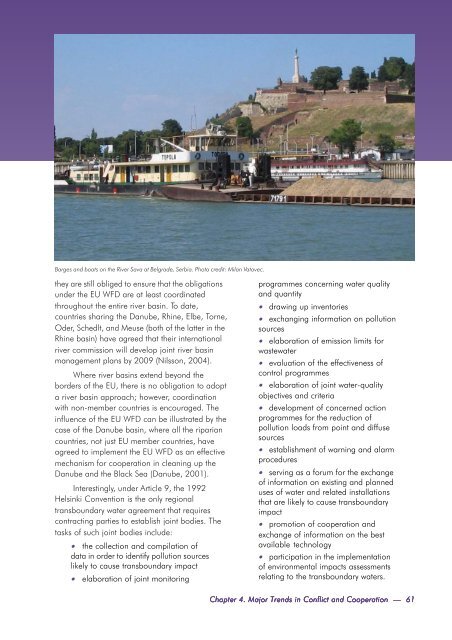Europe - UNEP
Europe - UNEP
Europe - UNEP
You also want an ePaper? Increase the reach of your titles
YUMPU automatically turns print PDFs into web optimized ePapers that Google loves.
Barges and boats on the River Sava at Belgrade, Serbia. Photo credit: Milan Vatovec.<br />
they are still obliged to ensure that the obligations<br />
under the EU WFD are at least coordinated<br />
throughout the entire river basin. To date,<br />
countries sharing the Danube, Rhine, Elbe, Torne,<br />
Oder, Schedlt, and Meuse (both of the latter in the<br />
Rhine basin) have agreed that their international<br />
river commission will develop joint river basin<br />
management plans by 2009 (Nilsson, 2004).<br />
Where river basins extend beyond the<br />
borders of the EU, there is no obligation to adopt<br />
a river basin approach; however, coordination<br />
with non-member countries is encouraged. The<br />
influence of the EU WFD can be illustrated by the<br />
case of the Danube basin, where all the riparian<br />
countries, not just EU member countries, have<br />
agreed to implement the EU WFD as an effective<br />
mechanism for cooperation in cleaning up the<br />
Danube and the Black Sea (Danube, 2001).<br />
Interestingly, under Article 9, the 1992<br />
Helsinki Convention is the only regional<br />
transboundary water agreement that requires<br />
contracting parties to establish joint bodies. The<br />
tasks of such joint bodies include:<br />
• the collection and compilation of<br />
data in order to identify pollution sources<br />
likely to cause transboundary impact<br />
• elaboration of joint monitoring<br />
programmes concerning water quality<br />
and quantity<br />
• drawing up inventories<br />
• exchanging information on pollution<br />
sources<br />
• elaboration of emission limits for<br />
wastewater<br />
• evaluation of the effectiveness of<br />
control programmes<br />
• elaboration of joint water-quality<br />
objectives and criteria<br />
• development of concerned action<br />
programmes for the reduction of<br />
pollution loads from point and diffuse<br />
sources<br />
• establishment of warning and alarm<br />
procedures<br />
• serving as a forum for the exchange<br />
of information on existing and planned<br />
uses of water and related installations<br />
that are likely to cause transboundary<br />
impact<br />
• promotion of cooperation and<br />
exchange of information on the best<br />
available technology<br />
• participation in the implementation<br />
of environmental impacts assessments<br />
relating to the transboundary waters.<br />
Chapter 4. Major Trends in Conflict and Cooperation — 61
















